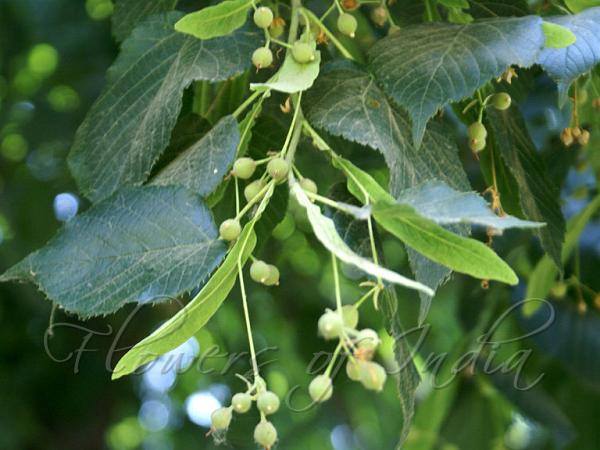|
| Large-Leaf Lime |
|

|

| File size | 123512 |
| Original date | 7/5/11 12:19 PM |
| Resolution | 768 x 576 |
| Flash | Flash did not fire, auto |
| Focal length | 50.0mm |
| Exposure time | 1/80s |
| Aperture | 5.6 |
| Focus Distance | |
| Metering Mode | Multi-segment |
| Camera make | SONY |
| Camera model | DSLR-A100 |
| Sensor type |
|
|
|
|
Photo: |
Botanical name: Tilia platyphyllos Family: Tiliaceae (Falsa family)
Large-leaved Limeis a deciduous tree native to
Europe, frequently planted as an ornamental tree in parks, or as a
shade tree or a lawn tree. It is a narrowly domed tree with a moderate
growth rate, and can eventually attain a height of 40 m. The
reddish-brown young stems later develop dark gray bark with fine
fissures and furrows. The branches spread upwards at wide angles. The
twigs are reddish-green and slightly pubescent. Alternately arranged
leaves, are larger than the related
Small Leaved Lime, 6 to 9 cm
(exceptionally 15 cm). They are ovate to heart-shaped, mid to dark
green above and below, with white downy hair on the underside,
particularly along the veins, tapering into a mucronate tip. The margin
is sharply toothed, and the base heart-shaped, the venation is palmate
along a midrib. The pubescent petiole is usually 3-4 cm long, but can
vary between 1.5-5 cm. The small, fragrant, yellowish-white flowers are
arranged in drooping, cyme-like clusters in groups of 3 to 4. Their
whitish-green, leaf-like bracts have an oblong-obovate shape. The
stalks carrying the clusters are between 1.5-3 cm long. The
hermaphroditic flowers have 5 sepals and 5 tepals, numerous stamens,
but no staminodes. The superior ovary is 2-10 locular with one smooth
style. The flowers are pollinated by bees. The fruit is a small, round,
velvety, cream-colored nutlet with a diameter of 1 cm or less. It has a
woody shell with 3-5 ridges.
Medicinal uses:  Although Tilia cordata is listed as the preferred medicinal
species, T. platyphyllos is also used medicinally and somewhat
interchangeably. The dried flowers are mildly sweet and sticky, and the
fruit is somewhat sweet and mucilaginous. Linden tea has a pleasing
taste, due to the aromatic volatile oil found in the flowers. The
flowers, leaves, wood, and charcoal (obtained from the wood) are used
for medicinal purposes. Active ingredients in the linden flowers
include flavonoids (which act as antioxidants), volatile oils, and
mucilaginous constituents (which soothe and reduce inflammation). The
plant also contains tannins that can act as an astringent.
Although Tilia cordata is listed as the preferred medicinal
species, T. platyphyllos is also used medicinally and somewhat
interchangeably. The dried flowers are mildly sweet and sticky, and the
fruit is somewhat sweet and mucilaginous. Linden tea has a pleasing
taste, due to the aromatic volatile oil found in the flowers. The
flowers, leaves, wood, and charcoal (obtained from the wood) are used
for medicinal purposes. Active ingredients in the linden flowers
include flavonoids (which act as antioxidants), volatile oils, and
mucilaginous constituents (which soothe and reduce inflammation). The
plant also contains tannins that can act as an astringent.
 Although Tilia cordata is listed as the preferred medicinal
species, T. platyphyllos is also used medicinally and somewhat
interchangeably. The dried flowers are mildly sweet and sticky, and the
fruit is somewhat sweet and mucilaginous. Linden tea has a pleasing
taste, due to the aromatic volatile oil found in the flowers. The
flowers, leaves, wood, and charcoal (obtained from the wood) are used
for medicinal purposes. Active ingredients in the linden flowers
include flavonoids (which act as antioxidants), volatile oils, and
mucilaginous constituents (which soothe and reduce inflammation). The
plant also contains tannins that can act as an astringent.
Although Tilia cordata is listed as the preferred medicinal
species, T. platyphyllos is also used medicinally and somewhat
interchangeably. The dried flowers are mildly sweet and sticky, and the
fruit is somewhat sweet and mucilaginous. Linden tea has a pleasing
taste, due to the aromatic volatile oil found in the flowers. The
flowers, leaves, wood, and charcoal (obtained from the wood) are used
for medicinal purposes. Active ingredients in the linden flowers
include flavonoids (which act as antioxidants), volatile oils, and
mucilaginous constituents (which soothe and reduce inflammation). The
plant also contains tannins that can act as an astringent. Identification credit: Gurcharan Singh
| Photographed in Emporium Garden in Srinagar, Kashmir. |